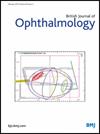Antimicrobial concentrations in the cornea and aqueous humour: a meta-analysis
IF 3.5
2区 医学
Q1 OPHTHALMOLOGY
引用次数: 0
Abstract
Aim To interpret the likely clinical susceptibility of isolates from microbial keratitis (MK), we performed a meta-analysis of published data that measured the concentrations of topically applied antimicrobials in the cornea or aqueous humour. We then correlated these values with the in vitro minimum inhibitory concentration (MIC). Methods We searched PubMed to identify studies reporting aqueous and/or corneal concentrations of 53 topically applied ocular antimicrobials, spanning the following classes: beta-lactams, glycopeptides, aminoglycosides, chloramphenicol, lincosamides, macrolides, oxazolidinones, steroidal antimicrobials, tetracyclines, diaminopyrimidines, sulphonamides, lipopeptides and polymyxins. Two clinicians independently screened the abstracts and extracted data from studies meeting the inclusion criteria, including participant species, antimicrobial concentration, dosing regimens, epithelial status and measurement methods. Concentrations were standardised to mg/L. The data were stratified by applied concentration, dosing regime and species. First quartile concentrations (EQ1) were extrapolated to provide a conservative estimate and tabulated practice resource for clinicians treating MK. Results We screened 7247 publications. 81 publications were included in the meta-analysis, comprising data on the aqueous and/or corneal concentrations of 28 antimicrobials. Bioassay was the most frequently used method for quantifying antimicrobial concentrations (25 studies), followed by liquid chromatography and fluorescence assays (18 studies each), mass spectrometry (12 studies) and radioactivity and colourimetric assays (3 studies each). Conclusion We provide a practical resource for clinicians to assess whether the expected EQ1 of an antimicrobial in the cornea is above the in vitro MIC of the pathogen. This reduces reliance on systemic break-point concentrations. This enables standardised guidelines for evidence-based antimicrobial treatment decisions for MK. All data relevant to the study are included in the article or uploaded as supplementary information. Not applicable.角膜和体液中的抗菌药物浓度:荟萃分析
为了解释微生物性角膜炎(MK)分离物可能的临床敏感性,我们对已发表的数据进行了荟萃分析,这些数据测量了角膜或体液中局部应用抗菌剂的浓度。然后我们将这些值与体外最低抑制浓度(MIC)相关联。方法:我们检索PubMed以确定53种局部应用的眼部抗菌剂的水溶和/或角膜浓度的研究,涵盖以下类别:β -内酰胺类、糖肽类、氨基糖苷类、氯霉素类、lincosamides类、大环内酯类、恶唑烷类、甾体抗菌剂、四环素类、二氨基嘧啶类、磺胺类、脂肽类和多粘菌素类。两名临床医生独立筛选摘要,并从符合纳入标准的研究中提取数据,包括受试者物种、抗菌药物浓度、给药方案、上皮状态和测量方法。标准浓度为mg/L。数据按施用浓度、给药制度和物种分层。外推第一四分位数浓度(EQ1),为临床医生治疗MK提供保守估计和制表实践资源。结果我们筛选了7247篇出版物。荟萃分析纳入了81篇出版物,包括28种抗菌剂的水溶和/或角膜浓度数据。生物测定法是定量抗菌药物浓度最常用的方法(25项研究),其次是液相色谱法和荧光法(各18项研究)、质谱法(12项研究)以及放射性和比色法(各3项研究)。结论为临床医生评估抗微生物药物在角膜中的预期EQ1是否高于病原体的体外MIC提供了实用的资源。这减少了对系统断点集中的依赖。这为MK的循证抗菌药物治疗决策提供了标准化指南。与研究相关的所有数据都包含在文章中或作为补充信息上传。不适用。
本文章由计算机程序翻译,如有差异,请以英文原文为准。
求助全文
约1分钟内获得全文
求助全文
来源期刊
CiteScore
10.30
自引率
2.40%
发文量
213
审稿时长
3-6 weeks
期刊介绍:
The British Journal of Ophthalmology (BJO) is an international peer-reviewed journal for ophthalmologists and visual science specialists. BJO publishes clinical investigations, clinical observations, and clinically relevant laboratory investigations related to ophthalmology. It also provides major reviews and also publishes manuscripts covering regional issues in a global context.

 求助内容:
求助内容: 应助结果提醒方式:
应助结果提醒方式:


